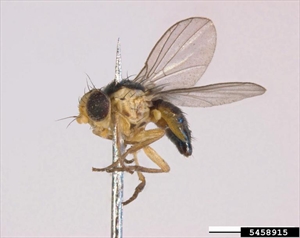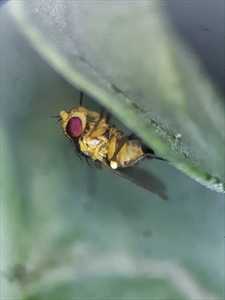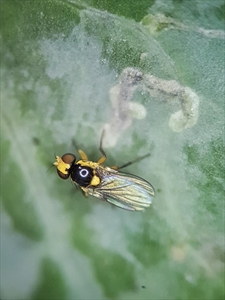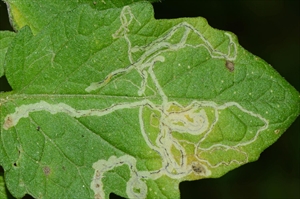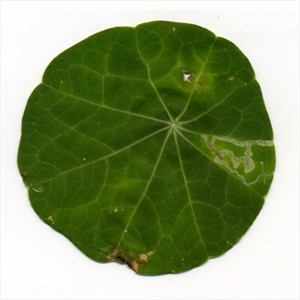Leafminers. See other fact sheets for accounts on separate species (Fact Sheet nos. 259, 262 and 377).
Pacific Pests, Pathogens, Weeds & Pesticides - Online edition
Pacific Pests, Pathogens, Weeds & Pesticides
Leafminers - General (110)
Liriomyza sativae (vegetable leafminer); Liriomyza trifolii (chrysanthemum leafminer or American serpentine leafminer), Liriomyza huidobrensis (serpentine leafminer); Liriomyza brassicae (cabbage or serpentine leafminer).
Worldwide (all species). Liriomyza brassicae is recorded from Asia, Africa, North and South America, Europe, Oceania. It is recorded from Australia, Fiji, Guam, Federated States of Micronesia, New Zealand, Northern Mariana Islands, and Papua New Guinea.
Liriomyza huidobrensis is recorded from Asia, Africa, North (Canada only), South and Central America, the Caribbean (Dominium Republic), Europe, Oceania. It is primarily a tropical and warm temperate species and has been found up to 3000 m. Within Oceania, it is recorded from Australia and Guam.
Liriomyza sativae is recorded from Asia, Africa, North (Hawaii), South and Central American, the Caribbean, Europe, Oceania. It is recorded from American Samoa, Australia (Cape York), Cook Islands, Federated States of Micronesia, French Polynesia, Guam, New Caledonia, Northern Mariana Islands, Papua New Guinea, Samoa, and Vanuatu.
Liriomyza trifolii is recorded from Asia, Africa, North, South and Central America, the Caribbean, Europe, Oceania. It is recorded from American Samoa, Australia, Guam, Federated States of Micronesia, Fiji, Northern Mariana Islands, Samoa, Solomon Islands, and Tonga. In 2021, it was recorded in north Queensland (Torres Strait) and Western Australia.
Liriomyza brassicae (Brassicaceae). A pests of the cabbage family (see Fact Sheet no. 377).
Liriomyza huidobrensis (Cucurbitaceae, Fabaceae, Asteraceae, Solanaceae, Liliaceae). A pest of potato, vegetables (lettuces, beans, cucumbers, celery) and ornamentals (chrysanthemum) in the field and glasshouses.
Liriomyza sativae (Cucurbitaceae, Braassicaceae, Solanaceae, Asteraceae, Fabaceae, Apiaceae, Liliaceae, Malvaceae). A pest of many vegetable crops, particularly capsicum. cucurbits, carrot, lettuce, onions, tomatoes, and also on cotton (see Fact Sheet no. 262). Important on tomatoes and celery in glasshouses.
Liriomyza trifolii (Asteraceae, Liliaceae, Fabaceae, Brassicaceae, Cucurbitaceae, Malvaceae). A pest of beans, cabbage, celery, Chinese cabbage, pigeon pea, tomato (Photo 2) and watermelon (see Fact Sheet no. 259), and many weeds. Note, the following crops are hosts in Fiji from border interceptions in New Zealand: Oregano, Amaranthus, basil, chives, sage, mint, rocket.
Female feeding and egg-laying punctures damage the leaves and petioles affecting photosynthesis and causing water loss. In addition, the larvae mine (tunnel) inside the leaves and petioles.
The adult is a tiny black and yellow fly 1.3-2.3 mm long depending on the species (Photos 1-4). The females are larger than the males. Females feed on sap from leaves, making holes with their ovipositors - the tubes used for egg laying; and both sexes take nectar from flowers.
Eggs are laid just beneath the leaf surface, beginning a day or so after the adults emerge, and continuing for several weeks. The eggs hatch after a few days and the larvae or maggots mine the leaves (Photos 5-7). The maggots are colourless at first, becoming green and then yellow as they mature; they are up to 3 mm long. Frass (larval faeces) is seen as black lines at the side of the mines.
During their life, the larvae go through three changes and then leave the mines, falling to the soil where they burrow for a few centimetres to pupate. The life cycle takes from less than 3 weeks to more than 9 weeks depending on the temperature and the host. At 30°C, Liriomyza. sativae takes 15 days from egg to adult.
Spread is by flying and by the movement of plants, both domestically and internationally, soil or packaging.
The impact of the four Liriomyza species stems from their wide host range, and ability to develop pesticide resistance rapidly. Further problems arise as some species are able to use new hosts when introduced to new environments, and this may alter parasitoid behaviour resulting in Liriomyza becoming less suitable hosts.
In general, the mining of leaves sets back growth, causing leaves to dry and fall early. Seedlings especially are impacted. Leaf fall in tomato exposes the fruit to sunlight and may result in sunburn (see Fact Sheet no. 085). Mines are also unsightly and on ornamental plants reduce their market value. Losses of 80% due to Liriomyza sativa are reported in celery in Florida, and similar loses in tomato and in alfalfa a forage crop have been reported. Damage is especially severe on seedlings and young plants. In Guam, Liriomyza trifolii was the most important pest of yard-long bean. Slow growth or death of young plants occurred, and an average number of four mines per leaf and above reduced yield.
Indirect damage also occurs. Liriomyza sativae transmits virus diseases (Watermelong mosaic virus) of celery and watermelon. However, damage through virus transmission is probably not as important as that of mining by the larvae or the adults feeding on the leaves.
Look for feeding punctures, which appear as white speckles about 0.15 mm in diameter. Egg laying punctures are smaller (0.05 mm) and round. Look for white mines or tunnels snaking over the leaf, invariably with faeces inside. The mines increase in width as the maggots mature. Identification of Liriomyza leafminers requires taxonomic expertise because of the similarity of the species.
In general, all the Liriomyza species mentioned here are black (sometimes brilliantly black) and yellow. The scutellum - the triangular spot on the top rear of the thorax - is usually bright yellow and distinctive. The similarity of the Liriomyza species mentioned here means that they may be mistaken for each other.
Yellow sticky traps placed within or near to crops are an effective method of estimating levels of infestation.
BIOSECURITY
Not all these species are present in each of the project countries, Fiji, Samoa, Solomon Islands, and Tonga. That being the case, it is necessary to prevent these leafminers from extending their range. In particular, quarantine authorities need to be alert to the fact that movement across national borders is associated with the trade in nursery plants, cut flowers and vegetables.
NATURAL ENEMIES
There are a large number of natural enemies of leafminers, which under most situations provide effective control. Waterhouse and Norris (1987) list over 40. However, many have proved to be more susceptible to insecticides than leafminers. Consequently, when resistant strains of leafminers developed in response to over-use of insecticides natural enemies are insufficient to control them. The strategy, therefore, is to preserve natural enemies by monitoring leafminer numbers, knowing the numbers likely to cause damage, and by careful choice of insecticide, and the timing of applications.
A number of parasitoids, mainly minute species of wasps, are thought to have particular promise in Pacific island countries, these are: Chrysocharis (parksii) oscinidis, Neochrysocharis diastatae (previously, Chrysonotomyia punctiventris), Diglyphus begini, Diglyphus intermedius and Banacuniculus utilis (previosuly, Ganaspidium hunteri). In Hawaii, Banacuniculus (Ganaspidium) utilis was important on Liriomyza sativae and Liriomyza trifolii attacking watermelon, Liriomyza trifolii on chrysanthemums, and Liriomyza trifolii and Liriomyza huidobrensis on celery. In Europe, Dacnusa sibirica is useful at low temperatures, and Diglyphus isaea when temperatures are above 20°C.
Note that Banacuniculus utilis and Chrysocharis oscinidus were introduced into Tonga from Hawaii in 1988 after Liriomyza trifolii became an important pest of watermelon, pumpkin, tomato, bean and Solanum potato. More than 4000 individuals of both species were made at 11 locations from September to December that year. Both species became established. In Hawaii, Ganaspidium utilis is a major parasitoid of Liriomyza sativae and Liriomyza trifolii on watermelon, beans and tomato, and Liriomyza sativae on shallots. Banacuniculus utilis has also given good control of leafminers on beans in Guam.
CULTURAL CONTROL
Cultural practices are important in preventing outbreaks of leafminers. Do the following:
- Remove or destroy crop residues by incorporating them into the soil or burning them.
- Remove weeds as they serve as a reservoir for leafminers.
CHEMICAL CONTROL
Natural enemies play an important role in limiting leafminer populations; therefore, pesticides should be chosen and applied with care, as indiscriminate use may worsen the situation by disrupting natural control. Some insecticides, particularly, synthetic pyrethoids, are effective, but there are strains of Liriomyza species that have become resistant to them. Abamectin, the growth regulator cyromazine, and spinosad provide control against larvae. Neem can be used against larvae.
However, white oil and horticultural oil are as effective as most synthetic insecticides and should be used in nurseries, home gardens and orchards. Methods of preparation of small amounts are provided (see Fact Sheet no. 056). The oils have a deterrent effect: females avoid leaves treated with oils, and so the number of eggs laid is less. They are also less harmful to natural enemies.
____________________
When using a pesticide (even a biopesticide), always wear protective clothing and follow the instructions on the product label, such as dosage, timing of application, and pre-harvest interval. Recommendations will vary with the crop and system of cultivation. Expert advice on the most appropriate pesticide to use should always be sought from local agricultural authorities.
AUTHOR Grahame Jackson
Information from Waterhouse DF, Norris KR (1987) Biological Control Pacific Prospects. Inkata Press; and Liriomyza huidobrensis (serpentine leafminer-https://www.cabi.org/cpc/datasheet/30956), Liriomyza brassicae (serpentine leafminer-https://www.cabi.org/cpc/datasheet/30949), Liriomyza sativae (vegetable leaf miner-https://www.cabi.org/cpc/datasheet/30960), and Liriomyza trifolii (American serpentine leafminer-https://www.cabi.org/cpc/datasheet/30965). Crop Protection Compendium; and Leaf miner (2020) Department of Agriculture and Water Resources. (hhttps://www.agriculture.gov.au/pests-diseases-weeds/plant/leaf-miner); and from Sooda A et al. (2017) Multiplex real-time PCR assay for the detection of three invasive leafminer species: Liriomyza huidobrensis, L. sativae and L. trifolii (Diptera: Agromyzidae). Austral Entomology 56, 153-159. Photo 1 Pest and Diseases Image Library, Bugwood.org. Photo 2&5 J. Poorani, National Bureau of Agriculturally Important Insects (formerly PDBC), Bangalore, Karnataka, India. Photos 3&4 Ella Pirtle, cesar Pty. Ltd., 293, Royal Parade, Parkville, Victoria, Australia. Photos 6&7 and editing Peter Ridland. University of Melbourne, Victoria, Australia.
Produced with support from the Australian Centre for International Agricultural Research under project PC/2010/090: Strengthening integrated crop management research in the Pacific Islands in support of sustainable intensification of high-value crop production, implemented by the University of Queensland and the Secretariat of the Pacific Community.
